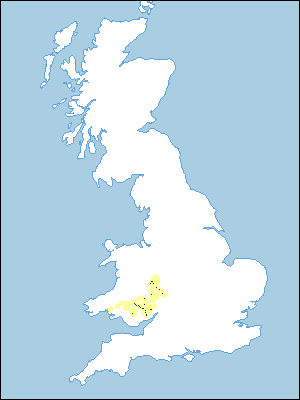
Soil Associations
0561d LUGWARDINE
Soil and site characteristics
Deep stoneless permeable reddish fine silty soils. Similar coarse silty soils locally. Associated with fine silty soils variably affected by groundwater. Flat land. Risk of flooding.
Geology
Reddish river alluvium
Cropping and Land Use
Stock rearing on permanent grassland; cereals, hops and potatoes where flood risk low.
Component soil series
| Subgroup | Series name | Percentage | WRB 2006 link |
|---|---|---|---|
| 5.61 | LUGWARDINE | 50% | Eutric Chromic Fluvic Cambisols |
| 5.62 | MATHON | 20% | Fluvic Eutric Chromic Cambisols |
| 8.11 | HOLLINGTON | 10% | Fluvic Eutric Gleysols |
| 5.61 | WALFORD | 10% | Chromic Fluvic Cambisols |
Covers 175 km2 in England and Wales
Soilscapes Classification
| 12 |
Freely draining floodplain soils |
0561d LUGWARDINE
Detailed Description
Reddish fine silty soils of the Lugwardine association are developed in riverine alluvium. They are extensive, covering 182 km², in the Welsh Borderland counties of Shropshire and Herefordshire and in south-east Wales. The soils are uniformly deep, stoneless, silty and permeable but many are subject to winter and spring floods which restrict their use. Typical brown alluvial soils of the Lugwardine and Watford series predominate with subordinate areas of soils affected by a seasonal groundwater-table represented by Mathon, gleyic brown alluvial soils, and Hollington series, typical alluvial gley soils. The association is extensive in the valleys draining reddish Devonian rocks and related drifts notably along the Teme, Lugg, Arrow and Corve. The freely drained fine silty Lugwardine and coarse loamy Walford series are usually found close to the streams often on levêes. The poorly drained Hollington series occupies lower areas, commonly at the back of floodplains away from the rivers, and Mathon soils usually occur in between. Many of the valleys are narrow and the full sequence of soils is not always represented. In south Herefordshire, around Ross-on-Wye the association includes a large proportion of coarse loamy Walford soils where streams drain sandstone country. In these valleys patches of coarse loamy Ty-Gwyn soils (Wright 1980), which suffer winter waterlogging and have faint mottles in subsoil horizons, are mapped. Occasionally small areas of river terraces are included where they are too small or narrow to map separately. They either flank the alluvium or occur as dissected remnants within the floodplain and carry stony coarse loamy typical brown earths, Newnham series. The catchments of some tributary streams are formed in brown rocks and brownish alluvial fans are sometimes built up on the dominantly reddish floodplains. The Teme and Clwyd series are developed on the fans and although locally important are only minor components. The association is extensive in the valleys draining reddish Devonian rocks and related drifts, notably along the Wye around Monmouth and the Usk between Brecon and Usk. The freely drained fine silty Lugwardine and coarse loamy Walford series are usually found close to the streams, often on levees. Poorly drained Hollington soils occupy lower areas, commonly at the back of floodplains. Many of the valleys are narrow and the full sequence of soils is not always represented. In the Usk valley and its tributary near Tretower the Walford series predominates.
Soil Water Regime
Short-lived winter and spring floods are common on this association unless there are protective embankments. Hollington soils are flooded longest because they are usually on the lowest ground. The Lugwardine and Walford series are well drained (Wetness Class I) and unaffected by groundwater. Mathon and Hollington soils, although both permeable, suffer seasonal waterlogging from groundwater. The Mathon series is only occasionally waterlogged (Wetness Class II or III) but Hollington soils have more prolonged waterlogging (Wetness Class IV and V). If outfalls are satisfactory Hollington and Mathon soils will benefit from underdrainage and be improved to Wetness Class III and II respectively.
Cropping and Land Use
Lugwardine soils are mostly under permanent grassland because of the risk of flooding. Their deep profiles have large available water contents, are easily exploited by roots, and grass therefore yields well, the land being much valued for hay and silage. During dry spells growth continues longer than on adjacent higher land even though in the Teme valley west of Worcester these soils are moderately droughty. The soils are not droughty for crops except in the driest areas. There is little poaching risk on Lugwardine, Walford and Mathon soils. Hollington series, with its water retentive topsoils is often waterlogged well into the grazing season and therefore can usually only be safely stocked during the summer. Cultivations are relatively easy with ample time for autumn landwork ). There arc also a few opportunities for spring cultivation except in wet years. Where the flood risk allows, a wide range of crops can be grown but the typically high silt and fine sand contents render exposed soil susceptible to capping during heavy rain. The Teme valley around Tenbury Wells, where flooding is rare, is famous for its hops and fruit. Both crops are grown on the Lugwardine association; the orchards are mainly cider apple although some fruit stock are raised. There has been a distinct increase in arable cultivation particularly for winter cereals in recent years. Where there is an appreciable risk of winter flooding crops are sown in spring to avoid damage by erosion or by rotting during inundation. Good yields are obtained from these naturally fertile soils although they tend to be slightly acid and require occasional dressings of lime.
0561d LUGWARDINE
Distribution Map
 |
Note that the yellow shading represents a buffer to highlight the location of very small areas of the association.
Keys to component soil series
Midlands
 |
Wales
 |
Typical Landscapes
Wales
All information Copyright, Cranfield University © 2025
Citation: To use information from this web resource in your work, please cite this as follows:
Cranfield University 2025. The Soils Guide. Available: www.landis.org.uk. Cranfield University, UK. Last accessed 04/04/2025
